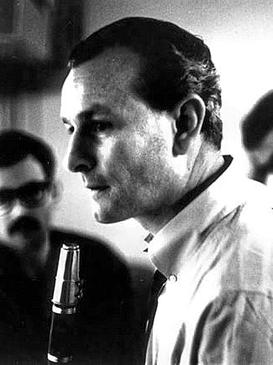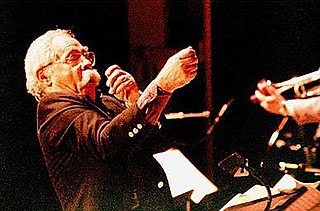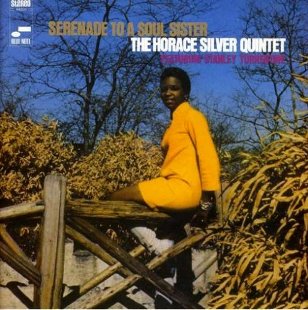
Coleman Randolph Hawkins, nicknamed "Hawk" and sometimes "Bean", was an American jazz tenor saxophonist. One of the first prominent jazz musicians on his instrument, as Joachim E. Berendt explained: "there were some tenor players before him, but the instrument was not an acknowledged jazz horn". Hawkins biographer John Chilton described the prevalent styles of tenor saxophone solos prior to Hawkins as "mooing" and "rubbery belches". Hawkins denied being first and noted his contemporaries Happy Caldwell, Stump Evans, and Prince Robinson, although he was the first to tailor his method of improvisation to the saxophone rather than imitate the techniques of the clarinet. Hawkins' virtuosic, arpeggiated approach to improvisation, with his characteristic rich, emotional, and vibrato-laden tonal style, was the main influence on a generation of tenor players that included Chu Berry, Charlie Barnet, Tex Beneke, Ben Webster, Vido Musso, Herschel Evans, Buddy Tate, and Don Byas, and through them the later tenormen, Arnett Cobb, Illinois Jacquet, Flip Phillips, Ike Quebec, Al Sears, Paul Gonsalves, and Lucky Thompson. While Hawkins became known with swing music during the big band era, he had a role in the development of bebop in the 1940s.

Gerald Joseph Mulligan, also known as Jeru, was an American jazz saxophonist, clarinetist, composer and arranger. Though primarily known as one of the leading jazz baritone saxophonists—playing the instrument with a light and airy tone in the era of cool jazz—Mulligan was also a significant arranger working with Claude Thornhill, Miles Davis, Stan Kenton, and others. His piano-less quartet of the early 1950s with trumpeter Chet Baker is still regarded as one of the best cool jazz ensembles. Mulligan was also a skilled pianist and played several other reed instruments. Several of his compositions including "Walkin' Shoes" and "Five Brothers", have become standards.

Henry Mobley was an American tenor saxophonist and composer. Mobley was described by Leonard Feather as the "middleweight champion of the tenor saxophone", a metaphor used to describe his tone, that was neither as aggressive as John Coltrane nor as mellow as Lester Young, and his style that was laid-back, subtle and melodic, especially in contrast with players such as Coltrane and Sonny Rollins. The critic Stacia Proefrock claimed him "one of the most underrated musicians of the bop era." Mobley's compositions include "Double Exposure", "Soul Station", and "Dig Dis".

James Peter Giuffre was an American jazz clarinetist, saxophonist, composer, and arranger. He is known for developing forms of jazz which allowed for free interplay between the musicians, anticipating forms of free improvisation.

Sonny Stitt was an American jazz saxophonist of the bebop/hard bop idiom. Known for his warm tone, he was one of the best-documented saxophonists of his generation, recording more than 100 albums. He was nicknamed the "Lone Wolf" by jazz critic Dan Morgenstern because of his tendency to rarely work with the same musicians for long despite his relentless touring and devotion to the craft. Stitt was sometimes viewed as a Charlie Parker mimic, especially earlier in his career, but gradually came to develop his own sound and style, particularly when performing on tenor saxophone and even occasionally baritone saxophone.
Robert "Bootsie" Barnes was an American jazz tenor saxophonist from Philadelphia.

Eric Alexander is an American jazz saxophonist, composer, and educator. Having placed second at the 1991 Thelonious Monk International Jazz Saxophone Competition behind Joshua Redman and ahead of Chris Potter and Tim Warfield, he was soon signed by a record label and has since recorded over 20 albums as a leader and over 300 as a sideman.

Edward "Kidd" Jordan was an American jazz saxophonist and music educator from New Orleans, Louisiana. He taught at Southern University at New Orleans from 1974 to 2006.

Emilio Castillo is an American saxophone player and composer, best known as the founder of the band Tower of Power.

Benny Green is an American hard bop jazz pianist who was a member of Art Blakey's Jazz Messengers. He has been compared to Bud Powell and Oscar Peterson in style and counts them as influences.

Scott Hamilton is an American jazz tenor saxophonist associated with swing and straight-ahead jazz. His eldest son, Shō Īmura, is the vocalist of the Japanese rock band Okamoto's.

Manny Albam was an American jazz arranger, composer, record producer, saxophonist, and educator.

James Moody was an American jazz saxophone and flute player and very occasional vocalist, playing predominantly in the bebop and hard bop styles. The annual James Moody Jazz Festival is held in Newark, New Jersey.

George Garzone is a saxophonist and jazz educator from Boston, Massachusetts.

Harry Allen is an American jazz tenor saxophonist born in Washington, D.C. Allen plays maintream jazz and bossa nova. He has performed live and recorded with Scott Hamilton, a tenor saxophonist to whom Allen has frequently been compared. He is best known for his work with John Colianni, Dori Caymmi, Keith Ingham, John Pizzarelli, and Bucky Pizzarelli.

Serenade to a Soul Sister is an album by jazz pianist Horace Silver released on the Blue Note label in 1968, featuring performances by Silver with Charles Tolliver, Stanley Turrentine, Bennie Maupin, Bob Cranshaw, John Williams, Mickey Roker and Billy Cobham.

Charles Davis was an American jazz saxophonist and composer. Davis played alto, tenor and baritone saxophone, and performed extensively with Archie Shepp and Sun Ra.
Dennis Taylor was an American musician, arranger, and author. Taylor had recording credits on saxophone as well as clarinet, and as an arranger.
Timothy M. Ries is an American saxophonist, composer, arranger, band leader, and music educator at the collegiate/conservatory level. Ries is in his seventeenth year as a professor of jazz studies at the University of Toronto. His universe of work as composer, arranger, and instrumentalist ranges from rock to jazz to classical to experimental to ethno to fusions of respective genres thereof. His notable works with wide popularity include The Rolling Stones Project, a culmination of jazz arrangements of music by the Rolling Stones produced on two albums, the first in 2005 and the second in 2008.
Anne Phillips is an American singer, songwriter, and producer. She has worked with Burt Bacharach, Carole King, Mahalia Jackson and has arranged and produced jingles for the Four Tops and Martha and the Vandellas.















